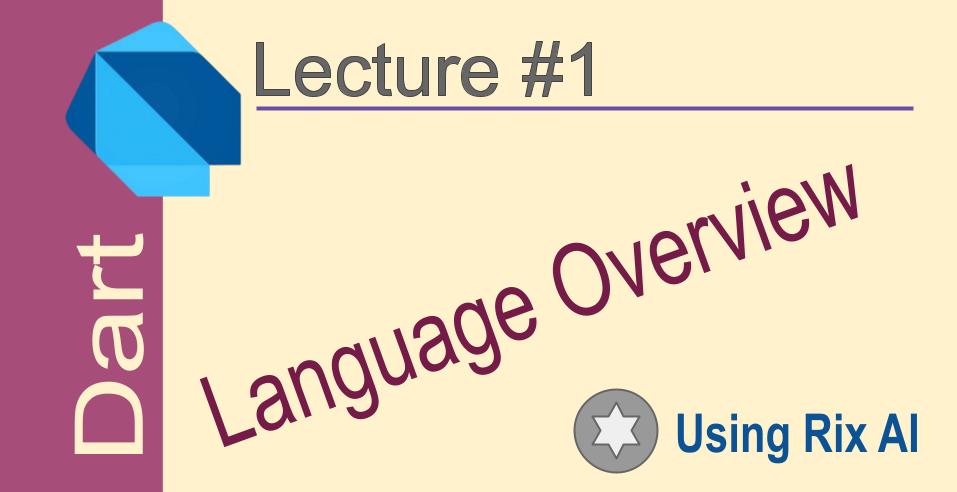Dart Overview
 Elucian Moise
Elucian MoiseTable of contents

Dart is a versatile, client-optimized programming language developed by Google. It is designed for building high-performance web, mobile, and desktop applications. Dart is known for its simplicity, readability, and powerful features, making it an excellent choice for both beginners and experienced developers.
Dart was created by Lars Bak and Kasper Lund, two Danish computer scientists who worked at Google at the time. They started working on the project in 2005 and unveiled it at the GOTO conference in Aarhus, Denmark, in October 2011. Dart was officially released in November 2013 and has since gained popularity among developers for its simplicity, performance, and cross-platform capabilities.
Key Features of Dart:
Object-oriented: Dart is an object-oriented programming language, emphasizing code organization and reusability through objects and classes.
Garbage-collected: Dart automatically manages memory allocation and deallocation, freeing developers from manual memory management tasks.
C-style syntax: Dart's syntax is similar to C and C++, making it easy for developers familiar with these languages to learn.
Ahead-of-time (AOT) compilation: Dart can be compiled to native machine code for improved performance on mobile and desktop platforms.
Just-in-time (JIT) compilation: Dart can also be compiled to JavaScript for web applications, ensuring compatibility with all major browsers.
Hot reload: Dart supports hot reload, allowing developers to see changes in their code instantly without restarting the application.
Sound null safety: Dart's type system prevents null-related errors, ensuring code reliability and reducing runtime crashes.
Rich set of libraries: Dart offers a comprehensive set of libraries for various development tasks, including networking, animation, and data manipulation.
Applications of Dart:
Web development: Dart is used to build interactive and performant web applications using frameworks like AngularDart and Flutter.
Mobile development: Dart is the foundation of Flutter, a cross-platform framework for building native-looking mobile apps for iOS and Android.
Desktop development: Dart can be used to develop desktop applications using frameworks like Fuchsia and Electron.
Server-side development: Dart can be used for server-side programming using frameworks like Aqueduct and Shelf.
Command-line tools: Dart can be used to create command-line tools and scripts for various automation tasks.
Dart's versatility and powerful features make it a compelling choice for building modern applications across various platforms. Its ease of learning and extensive community support further enhance its appeal to developers of all skill levels.
Success Stories
Many companies have used Dart successfully to build their applications. Here are a few examples:
Google: Google uses Dart for a variety of its products, including AdWords, Flutter, and AngularDart.
Alibaba: Alibaba uses Dart for its Xianyu application, which has over 20 million monthly active users.
Groupon: Groupon uses Dart for its mobile and online applications.
Philips Hue: Philips Hue uses Dart for its mobile and online applications.
Workiva: Workiva uses Dart for its cloud-based productivity platform.
Capital One: Capital One uses Dart for its web applications.
Khan Academy: Khan Academy uses Dart for its mobile and online learning platform.
SoundCloud: SoundCloud uses Dart for its mobile and online music platform.
Grammarly: Grammarly uses Dart for its grammar and spell checking tools.
King.com: King.com uses Dart for its mobile games, including Candy Crush Saga and Bubble Witch Saga.
These are just a few examples of the many companies that have used Dart successfully. Dart is a powerful and versatile language that is well-suited for a variety of applications.
Here are some success stories about Dart:
AdWords: Google's AdWords team rewrote their front-end code using Dart, resulting in a 30% performance improvement.
Flutter: Flutter is a cross-platform framework that uses Dart to build native-looking mobile apps for iOS and Android. Flutter has been adopted by a number of large companies, including Alibaba, ByteDance, and eBay.
AngularDart: AngularDart is a web framework that uses Dart to build single-page applications. AngularDart is used by a number of large companies, including Google, IBM, and Lockheed Martin.
These are just a few examples of the many success stories that have been achieved with Dart. Dart is a rapidly growing language with a bright future.
Learning Dart
If you already know Java, you should be able to learn Dart relatively quickly. This is because Dart shares many similarities with Java, both in terms of syntax and underlying concepts. For instance, both Dart and Java are object-oriented programming languages with a similar class structure and inheritance mechanism. Additionally, both languages utilize garbage collection for memory management, freeing developers from manual memory allocation and deallocation.
Here are some specific aspects of Dart that will make it easier for Java developers to learn:
Similar Syntax: The syntax of Dart is very similar to Java, making it easy for Java developers to read and understand Dart code.
Object-Oriented Concepts: Dart is an object-oriented programming language like Java, so Java developers are already familiar with the core concepts like classes, objects, inheritance, and polymorphism.
Garbage Collection: Both Dart and Java employ garbage collection for memory management, so Java developers don't need to worry about manual memory allocation and deallocation.
Similar Libraries: Dart and Java have similar libraries for common tasks like networking, data manipulation, and input/output, making it easier for Java developers to transition to Dart development.
Given these similarities, a Java developer with a decent understanding of object-oriented programming and programming fundamentals should be able to grasp the basics of Dart within a few days or weeks, depending on their learning pace and dedication. However, becoming proficient in Dart and fully mastering its advanced features may take more time and practice.
Here's a suggested learning approach for Java developers:
Start with the Basics: Begin by learning the fundamental syntax of Dart, including variables, data types, operators, control flow statements, and functions.
Explore Object-Oriented Concepts: Delve into the object-oriented aspects of Dart, including classes, objects, inheritance, polymorphism, and interfaces.
Practice with Examples: Reinforce your understanding by working through hands-on exercises and examples to apply the concepts you've learned.
Build Simple Applications: Once you're comfortable with the basics, start building simple Dart applications to gain practical experience and solidify your knowledge.
Explore Advanced Features: As you progress, explore more advanced Dart features like asynchronous programming, type annotations, and reflection.
Engage with the Community: Join online forums and communities dedicated to Dart development to seek guidance, ask questions, and learn from experienced Dart developers.
Remember, consistency and regular practice are key to mastering any programming language. By dedicating time and effort, you can effectively transition from Java to Dart and become a proficient Dart developer.
About this series
In this new series of articles, I will cover dar fundamental concepts. Before you start this course you should get familiar with general concepts of Software Engineering.
Disclaim: This article is generated using Rix AI.
Subscribe to my newsletter
Read articles from Elucian Moise directly inside your inbox. Subscribe to the newsletter, and don't miss out.
Written by

Elucian Moise
Elucian Moise
Software engineer instructor, software developer and community leader. Computer enthusiast and experienced programmer. Born in Romania, living in US.